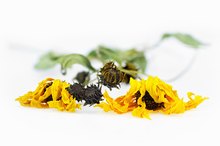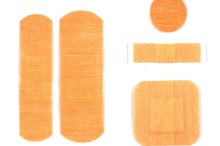Neosporin for Scar Removal
Neosporin is a popular antibiotic first aid ointment used on minor cuts, scratches, etc. According to the manufacturer, using Neosporin can help minimize the appearance of scars when the injury heals. Neosporin is easily available over the counter in most drug stores, supermarkets and anywhere else first aid supplies are sold.
Uses
Neosporin products are for first aid use only, such as on minor scrapes, cuts, burns and scratches. You should not use them on large or deep wounds and severe burns, which require a doctor's attention. In addition to soothing the wounded area, Neosporin works to minimize scarring and speed up healing time, according to the Neosporin website.
Application
Arnica Poisoning
Learn More
Before applying Neosporin, wash your your hands and remove any old medical dressings from the wound. Wash the affected area with soap and water to remove dirt, debris and old ointment, according to the Medical Center at Ohio State University 1. With your clean fingers, gently spread a thin layer of Neosporin over the entire wound. Wash your hands again, and then re-dress the wound.
- Before applying Neosporin, wash your your hands and remove any old medical dressings from the wound.
Infections
According to the Medical Center at Ohio State University, you should examine your wound for signs of infection before applying Neosporin 1. Signs of infection include a fever over 101 degrees Fahrenheit, fluid buildup under the skin, a foul smell or red, swollen and/or hot skin. If you exhibit any of these symptoms, contact your doctor and do not apply Neosporin to the affected area.
Warnings
How to Lance a Wound
Learn More
Consult your doctor if your wound condition becomes worse or if you have an allergic reaction such as swelling, itching, hives, blisters, redness, pain or burning sensation. You should also should not use Neosporin for more than one week unless you've spoken with a doctor.
Storage
Refer to the packaging of your Neosporin to find the stamped expiration date, and do not use it past this date To keep your Neosporin from going bad before the expiration date, keep it stored in a dry space at room temperature. Also keep the lid on tight; place it in a plastic bag or container if the lid becomes faulty or if a tear occurs.
Related Articles
References
- Medical Center at Ohio State University: Neosporin Ointment
- Heal CF, Banks JL, Lepper PD, Kontopantelis E, van Driel ML. Topical antibiotics for preventing surgical site infection in wounds healing by primary intention. Cochrane Database Syst Rev. 2016;11(11):CD011426. Published 2016 Nov 7. doi:10.1002/14651858.CD011426.pub2
- Jones RN, Li Q, Kohut B, Biedenbach DJ, Bell J, Turnidge JD. Contemporary antimicrobial activity of triple antibiotic ointment: a multiphased study of recent clinical isolates in the United States and Australia. Diagn Microbiol Infect Dis. 2006;54(1):63-71. doi:10.1016/j.diagmicrobio.2005.08.009
- Tong QJ, Hammer KD, Johnson EM, Zegarra M, Goto M, Lo TS. A systematic review and meta-analysis on the use of prophylactic topical antibiotics for the prevention of uncomplicated wound infections. Infect Drug Resist. 2018;11:417–425. Published 2018 Mar 16. doi:10.2147/IDR.S151293
- Shahbazian JH, Hartzell TL, Pandey AK, Azari KK. Allergic dermatitis due to topical antibiotics. West J Emerg Med. 2012;13(4):380–382. doi:10.5811/westjem.2011.9.6851
- Moore NA, Czyz CN, Carter TD, Foster JA, Cahill KV. Neomycin, polymyxin B, and dexamethasone allergic reactions following periocular surgery. J Ophthalmic Inflamm Infect. 2017;7(1):15. doi:10.1186/s12348-017-0133-4
- Chokshi A, Sifri Z, Cennimo D, Horng H. Global Contributors to Antibiotic Resistance [published correction appears in J Glob Infect Dis. 2019 Jul-Sep;11(3):131]. J Glob Infect Dis. 2019;11(1):36–42. doi:10.4103/jgid.jgid_110_18
- Suzuki M, Yamada K, Nagao M, et al. Antimicrobial ointments and methicillin-resistant Staphylococcus aureus USA300. Emerg Infect Dis. 2011;17(10):1917–1920. doi:10.3201/eid1710.101365
- Williamson DA, Carter GP, Howden BP. Current and Emerging Topical Antibacterials and Antiseptics: Agents, Action, and Resistance Patterns. Clin Microbiol Rev. 2017;30(3):827–860. doi:10.1128/CMR.00112-16
- Smack DP, Harrington AC, Dunn C, et al. Infection and allergy incidence in ambulatory surgery patients using white petrolatum vs bacitracin ointment. A randomized controlled trial. JAMA. 1996;276(12):972-7. doi:10.1001/jama.1996.03540120050033
- Guo S, Dipietro LA. Factors affecting wound healing. J Dent Res. 2010;89(3):219–229. doi:10.1177/0022034509359125
- Drexler M; Institute of Medicine (US). What You Need to Know About Infectious Disease. Washington (DC): National Academies Press (US); 2010. I, How Infection Works.
- Negut I, Grumezescu V, Grumezescu AM. Treatment Strategies for Infected Wounds. Molecules. 2018;23(9):2392. Published 2018 Sep 18. doi:10.3390/molecules23092392
- Sood A, Granick MS, Tomaselli NL. Wound Dressings and Comparative Effectiveness Data. Adv Wound Care (New Rochelle). 2014;3(8):511–529. doi:10.1089/wound.2012.0401
- Dhivya S, Padma VV, Santhini E. Wound dressings - a review. Biomedicine (Taipei). 2015;5(4):22. doi:10.7603/s40681-015-0022-9
- Suzuki M, Yamada K, Nagao M, et al. Antimicrobial ointments and methicillin-resistant Staphylococcus aureus USA300. Emerg Infect Dis. 2011;17(10):1917–1920. doi:10.3201/eid1710.101365
Writer Bio
Wendy Rose Gould is a professional journalist who has contributed to "Glamour" magazine and the Huffington Post, among other publications. After internships at the "Indianapolis Business Journal," "Kiwanis International" and "NUVO Newsweekly," she earned BA degrees in journalism and philosophy from Franklin College in 2008. Gould specializes in lifestyle topics.








